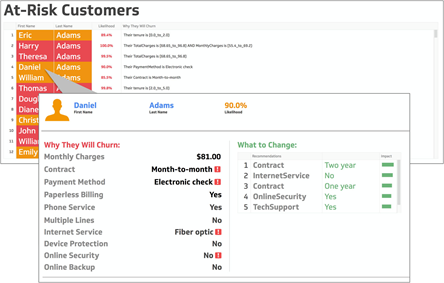
How to Make Your Analytics Projects Pay

(kentoh/Shutterstock)
I was talking to an executive and he commented that his organization is struggling to gain value from their analytics initiatives. “It always looks good when it’s drawn on the board,” he said. “But that is not how it plays out. The other executives agreed with him—they were also scratching their heads about this analytics thing.
We discussed and debated and I offered up the three rules I have found to be critical to the success of any real-world analytics initiative:
- Problem: Clearly define the problem that needs to be solved.
- Answers: Seek answers that contain a clear action that a person or machine can take to improve a problem.
- Execution: Clearly define how the workforce will consume and act on the answers to deliver ROI.
Let’s look at these rules at play in a few real-world success stories.
Success Story #1
One of my favorite success stories is a global telecommunications company that engaged my company to reduce the number of customers who leave every quarter for the greener pastures of a competitor. This is called “subscriber churn.”
Customer churn is a big problem for all telecommunications companies. It drives up operating costs, eats into margins, and it’s extremely persistent. Solutions to combat churn haven’t made a real, sustained dent. But every percentage point they can shave off customer churn equals big hard dollar return for the company, so they were keen to look outside their backyard for solutions.
Churn is their clearly defined problem. Next, they needed to make sure they could get real answers.
To solve customer churn, it’s very important to know what sort of answers the analytics will provide and how they can be used. This may sound silly, but let’s think about it. The typical “answer” from a churn analysis is a business intelligence report with drill-down capability. It’s informational, and you can stare and compare, but it does not show you how to solve the problem. Not very helpful.
The answer this telco gets from Emcien’s analytics is a ranked list of customers who are most likely to churn with supporting reasons why, based on the patterns of similar customers who have churned in the recent past. The supporting reasons show the telco what to do to solve the problem. For example, Daniel Adams has a 90% likelihood of churning because he is on a monthly plan, has received overage charges, and does not have Internet or security products. To keep Daniel from churning, the telco can consider reversing his latest overage charge or suggest he move to the annual plan or add Internet or security products to his bundle.
Having this information readily available at every point of customer interaction means the telco can apply the remedies in real-time and reduce churn.
The telco gets the answers they need from Emcien. Next, they needed to focus on execution.
To realize ROI, the critical question that needed to be answered was “who will use the answers and what will they do with them?” This is the “last mile” problem, and the success of analytics rests on the workforce’s ability to consume the answers inside existing workflows.
The telco knew that every customer interaction was an opportunity to use analytics to reduce churn, so they integrated the analytics into the apps their teams use every day, and the systems like the ecommerce website that run their business, so the entire customer-facing workforce—the humans and machines—could use each interaction to improve customer loyalty.
Here is how their workforce executes today:
- During inbound calls, contact center agents can see if a customer is at-risk of churn, why, and what to do, right inside their contact center application, helping the agent make the perfect offer to improve customer satisfaction.
- Emcien’s answers are also integrated into their marketing applications, actively pushing the most effective offers to customers who are at risk of churning.
- Emcien answers are also fed into the inside sales dashboard, so reps can proactively reach out to high-risk customers, in order of priority, to delight them with stellar service and tailored offers.
Emcien’s answers are embedded seamlessly into the organization and no one is even aware that the customer interaction is being powered by analytics. Kind of like the product recommendations on Amazon that are powered by analytics, guiding you to constantly discover new products and value.
Analytics should not be a stand-alone application. Analytics should be used as an add-on feature that feeds answers into your existing applications, enhancing current workflows with data-driven answers to empower your workforce and generate real ROI.
In this example, the telco has reduced customer churn by a measurable 17% while also improving customer experience, efficiency, and revenue.
Success Story #2
Another favorite success story is a national retailer that increased the value of each customer and increase retention.

(Sarawut Aiemsinsuk/Shutterstock)
Acquiring new customers was very expensive. And with the rise of disruptive brands and the shift to digital, keeping existing customers, and keeping them buying, has become harder – and more important – than ever. Because of the massive scale of retail, even a small increase in order value, purchase volume, and loyalty yields big revenue gains for the company.
This retail team was using a one-size-fits-all approach to marketing, sales, and service. Every customer got the same messages, the same offers, and the same level of customer support. They knew they were wasting important resources on bad customers, and not doing enough for their best customers, but they didn’t know which was which, or how to change their approach.
They now use analytics to know exactly which customers can drive the most value for the organization, so they know where to focus resources. The analytics provides them a ranked list of “best prospects,” or customers that just need a little prompting to become their highest value customers, and a list of “at-risk loyalists,” which are customers whose value is slipping and need some focused TLC to increase spending to the highest levels again. Each prospect or loyalist is identified based on patterns of behavior of previous customers.
The retailer is also given the supporting reasons why, so they know what to do to improve the value of each customer. And they know exactly what promotions, products, marketing messages, and customer service experiences will be most effective with each individual customer.
Emcien’s answers are integrated into existing applications, and are then fed into workflows of employees – service, marketing, sales – who are interacting with customers on a daily basis, ensuring each customer touch point is used to improve customer experience and retention.
The results? They’ve improved customer value 21% while also improving revenue, efficiency, and customer experience.
Success Story #3
A third success story involves a leading manufacturer that used analytics to ensure their deliveries are on time, every time.
The complexity of supply chains has grown exponentially, making them vulnerable to the daily exceptions that delay deliveries and lose customers and revenue while driving up operating costs.

(wavebreakmedia/Shutterstock)
This manufacturer, like many others, used planning tools and focused on supply chain visibility to ensure their supply chains ran smoothly. But these tools didn’t prevent exceptions and did little to solve the natural chaos that led to delayed deliveries.
The company’s analytics provides a list of ranked shipments most likely to be delayed based on historical patterns of previously delayed orders, and supporting reasons why. This information is fed into the order management application to prioritize the orders at risk of delay.
They are able re-prioritize orders and rearrange work schedules to address at-risk deliveries in order of importance. They use their email and SMS systems to proactively notify customers about potential delays, and their customer service staff knows a customer’s delivery may be delayed and how to respond before they even pick up the phone to answer a customer call.
As a result, they’ve reduced late deliveries 65% and reduced just-in-case inventory, strengthened customer loyalty and revenue, and lowered overall cost to serve.
A Winning Formula to Gain ROI
As these three use cases illustrate, it’s not just possible that analytics can add big, measurable value to organizations of all different stripes, it’s proven. And big, measurable value in today’s world is hard to come by and equally hard to survive without.
So, what is the roadmap that the three companies followed in the three use cases, to make their analytics deliver ROI?
The single biggest takeaway is this: To gain ROI from analytics, you need a well-defined problem and answers integrated seamlessly into your workforce’s existing workflows so they can act.
Virtually any business can follow this tried-and-true roadmap to achieve measurable value from their data.
About the Author: Radhika Subramanian is a recognized innovator in analytics, with a proven track record with brands such as NCR, Ericsson, Cisco, Dell and more. She is the CEO of Emcien Corporation, a prescriptive analytics software company that helps enterprises solve the last mile of analytic and realize maximum value from their data. Before Emcien, Radhika was CEO of Idmon, an analytics company that transformed the airline industry through data. She is recognized as a Leading Woman in Technology by WIT, was a finalist for the Franz Edelman Prize in Excellence in Management Science.
Related Items:
Companies Struggle to Find an ROI on Analytics
8 Tips for Achieving ROI with Your Data Lake






























